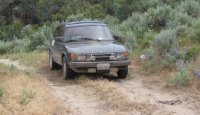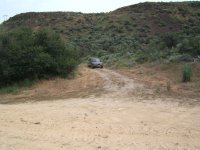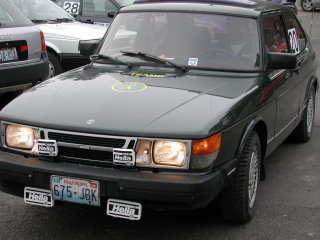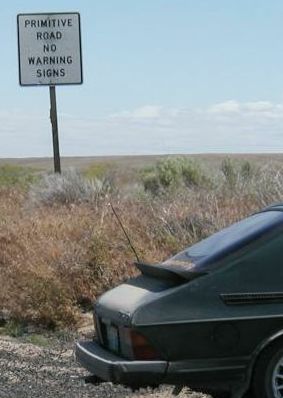Summary: Despite technical problems, made it back home from working
No Alibi with the car. It was a moderately successful shakedown for the Alaska trip in August; I found some weak points that need addressing. I also found some things I'd screwed up, not the least was working on so many different things at once over the past few weeks.
Long winded version follows:
Picked up the car at 5:30 on Friday afternoon. The shop owner made things right as promised, and didn't charge labor for putting the car back together for me. He took the time to show me the part that had been installed wrong, and we had a great chat, while everyone else was trying to get out for the weekend :) Including me. He was disappointed that they didn't get the skid plate installed -- it was kind of hidden in a garbage bag in the back. Their attention to detail as far as what had to be done was quite good, and they even arranged the alignment for me, delivering and picking it up. I will most likely have them give the car another once-over before leaving for the
Alcan 5000 rally in August.
On the way home, lots of smoke from under the hood. Stopped to find oil dripping from the turbo supply lines (my work). Continued home and while waiting for things to cool switched to gravel tires, then tightened quite a few loose bolts, including some on the turbo itself. Good thing the skid plate wasn't in the way after all. My friend helped with these tasks, and when I had him start the car while I was under it to check for more leaks, he snapped the key off in the ignition. My wife had twisted it last year so it was already weak. Should have replaced it sooner.
Got the leaks stopped, and reinstalled the A/C evaporator in the firewall. Packed my crap. Decided to go with the snapped off key, which still could be made to work, and use the good key to lock up when needed. Wife couldn't believe I was leaving for the weekend with a 1/2" ignition key stub. Got out the door around 7:30, about two hours behind schedule. Took a boatload of tools and some jackstands and planned on installing the skid plate in the parking lot at the start in Wenatchee the next morning. Jim took his car, the WRX, as we were both needed to work the rally. We convoyed over the pass with the event rallymaster and his dad, making good time.
Saturday morning found me installing the skid plate, to the amusement of competitors and workers alike. There's a tradition for someone to be working on an old Saab at these events. The entrant with an '86 900T loaned me a hex key to get the bumper off, and I promised to give him my old stock plate. Got on the road and to the first checkpoint (CP). I was tapped to run sweep, so would follow all the cars once they went past and lend a hand in case any got into trouble. Is the irony delicious yet?
Things went smoothly for the first three sections, and I was enjoying the handling (and not a little boost here and there) up to the lunch break, which I skipped so I could get ahead of the pack and set up for another checkpoint. All went well, but when I started up to chase after them, the car began running rough. Caught up to the scoring car, said "go ahead -- this will only take a sec", popped the hood, and found nothing obvious. Continued up the road and at about the seven mile mark, seven miles past pavement, the car completely died. A small amount of panic - I'm supposed to be an asset on this event, not a problem. Left a message with Hans and eventually settled down, thought things through, and determined it was an obvious spark problem. Coil wire seemed loose, and one spark plug wire fell out of the distro cap. The distributor sensor wire may have been loose as well. Put it all back together and she started right up. At this point I was about thirty minutes behind the pack, and tried to catch up. I really didn't dawdle in order to play catchup, but damn, it sure was fun. The roads up there can be tricky -- you think you can see the road going straight for a mile or so, but there are little crests interspersed, where the road will do a couple of fairly tight curves through a ravine. I had a couple of "holy crap!" moments but the gravel tires and road holding of the car kept me and the car unscathed. Just before one of those is when I placed my "no worries" message to Hans, thinking to myself, "quit buggin' Hans -- he has better things to do than listen to you whine your way across central Washington!"
Anyway I couldn't safely make up enough time without delaying the scoring car and some of the CP workers. We figured out over the ham radio that I would skip ahead through Coulee, and take the scoring car's CP east of Creston, and then we swap our jobs back to the original plan. Pulling in to Grand Coulee for gas, the steering was really heavy. While fueling I couldn't find a low tire, but did find a complete lack of steering fluid. Hmm. Didn't see an obvious leak -- maybe speeding down the gravel roads blasted it, or the big puddles I hit at speed.... Anyway I put a quart in and kept going, hoping that it was a slow leak that started day before.
Another forty miles to my CP, and I found that my hopes were too optimistic. The poer steering reservoir was dry again. More poking around found one of the pressure lines to the rack loose. No way to get to tighten it from above, and I didn't want to get under the car with no one else around. Also, don't want to bother the competitors for help, or the other workers. I decided to cut the belt so as not to completely trash the pump (being optimistic, of course) and work on it when we get in to Colville.
Had an uneventful trip, and finished sweep duties for the day. Our club hosted a great dinner as well as a DVD we made from a 1965 event. I found a spot in the motel parking lot with a curb that ramped up a couple of feet, drove the LF tire up it as far as I could and got under to tighten the PS line and zip-tie the lines to the rack. I had that on my to-do list in the car, but Scanwest didn't check it, and I didn't either. That's my oops, and I think the cause of the loosened PS line. All that rattling on the gravel roads combined with unsecured PS lines is recipe for *something* to come loose.
A few cocktails, then bed, admiring a handful of old cars that were also at the motel, including a trio of nicely restored Morgans. Some classic car group was in town and staying at the motel as well.
Sunday morning, raining steadily. Wipers won't work. Then they do after I fiddle with wires and change a fuse. Again I have the first checkpoint, so I get out early, do my timing, and start catching up to sweep a few sections. On the way to the second TSD section, I get in with the three Morgans, two in front, one behind. About a half mile from where I'm to turn off Hwy 20 for the Sherman Creek road, a cow moose and calf stroll out onto the road. The two cars in front of me brake to a stop, and while I'm slowing I see the car behind me fishtailing like crazy on the wet road. I have to dive off to the right shoulder, almost hitting the moose, to avoid getting a Morgan up my butt. Everyone squirms out ok, though, and we all wave and go on our way.
Sherman Creek Road is a total blast. It starts at the base of the major climb and reenters Hwy 20 at around the 4500 elevation mark. I wish it were a little closer than the other side of the state, though. Up and over Sherman Pass, which is a great highway drive, though the scenery wasn't much in the rain.
Got fuel in Republic and everything was going smoothly, despite the ribbing from fellow workers over the radio about whether I'm still underway or on a side road with the hood up. Weather is clearing as we head west and I sweep two more sections, then have to jump ahead during the lunch break in Omak to hide for a CP outside of Brewster. Made it with minutes to spare, and scored all the cars (23 entrants, by the way).
After everyone is past, I started the car to sweep the last sections, and there is a horrific grinding/rattling noise from under the hood. The car started fine, and idled ok (from what I can tell through the noise) and it first sounds like the alternator or water pump. I radio to the scoring car that I'm going to head for the highway in case things get worse. On the way down the hill, the noise is getting louder. I pull over and pop the hood while it's idling once I hit pavement. There's smoke coming from under the intake manifold. Could it be the starter? That's wacky. It sounds like the flywheel is trying to claw its way past the clutch. I shut it down because the noise is really atrocious, poke around a bit, and can't find anything obviously wrong, except for the burning smell and metallic smoke.
Tried to start the car and nothing -- the starter just spins with a strange whirring noise. Panic hits again. Have I ground the teeth off the flywheel? Fried the clutch? Is the chain drive in the tranny tits up? Crap! I don't know! I have cell service and call AAA for a tow to Wenatchee -- finding that it's just inside the 100 mile max service I've purchased. That's where the rally is ending and I figure that I can get help finding a tow vehicle to get the car home.
So while I'm waiting I pack away anything that's obvious about me being associated with a rally. The route book, the rally computer, the clipboard with my CP log, all go into the gadget bag. I pull the fog lights off, in case they will be in the way of the tow, and settle down to wait. And wait. The tow truck company calls to ask why AAA is sending me to Orondo? WTF? I need to go to Wenatchee, and once I explain why, they say no problem.
The tow driver shows up with a flat bed truck (woo hoo!) and his eight year old daughter. He has me turn the key (stub) and thinks the timing belt is shot. "no, wait, that's not it. The timing belt is the other way." Turns out this guy used to work on Saabs over ten years ago in California. He seems to know his way around, at least a little bit, but is stymied by the noise the car is making when I crank the key (stub).
So we head down the road, and he regales me with tales of going to jail, going to Saab tech training, and about a Saab he maintained for a local lawyer. Meanwhile I'm going over in my head everything that happened, and I interrupt him to say, "wait a minute, the car started and ran fine, it was a separate noise from idling, could it be something in the starter itself that got jammed and then eaten by the flywheel?" He thinks for a second and agrees, and suggests we try and do a compression start. We stop in Pateros and find a likely spot; he'd loaded the car on the bed so it was facing backward. I got in the car, he raised the ramp, and then unhooked everything and gave a slap on the trunk. Down I rolled, and BLIP, she starts up no problem in 2nd gear. Leaving the car idling, I sign the paperwork, slip him an extra $20 ( saving a fortune in tow bills for the rest of the way home) and make tracks for home. Instead of towing me for close to 80 miles, we've only gone six or seven.
The remainder of the drive was uneventful, except for eyeballing the fuel gauge. It's no problem to make it from Republic to Lake Forest Park on a tank of gas, even if you hit a few unpaved roads along the way. About 300 miles. Not a bad range.
I'm really glad I picked up a starter on eBay last year. It was for the '90 as I thought that starter was making odd noises, but I think it'll go in the '85.
As it stands, I think at least one more shakedown is in order.
Still to do, besides the starter: rear suspension bushings, aux light re-wiring, gather some more spare parts, and re-hab some of the door and hatch seals. Things got awfully dusty inside over the weekend, just on Saturday. Also need to remove the A/C evaporator assembly and replace with a filter from a non-A/C car. After the last couple of weeks, the list isn't very daunting.




